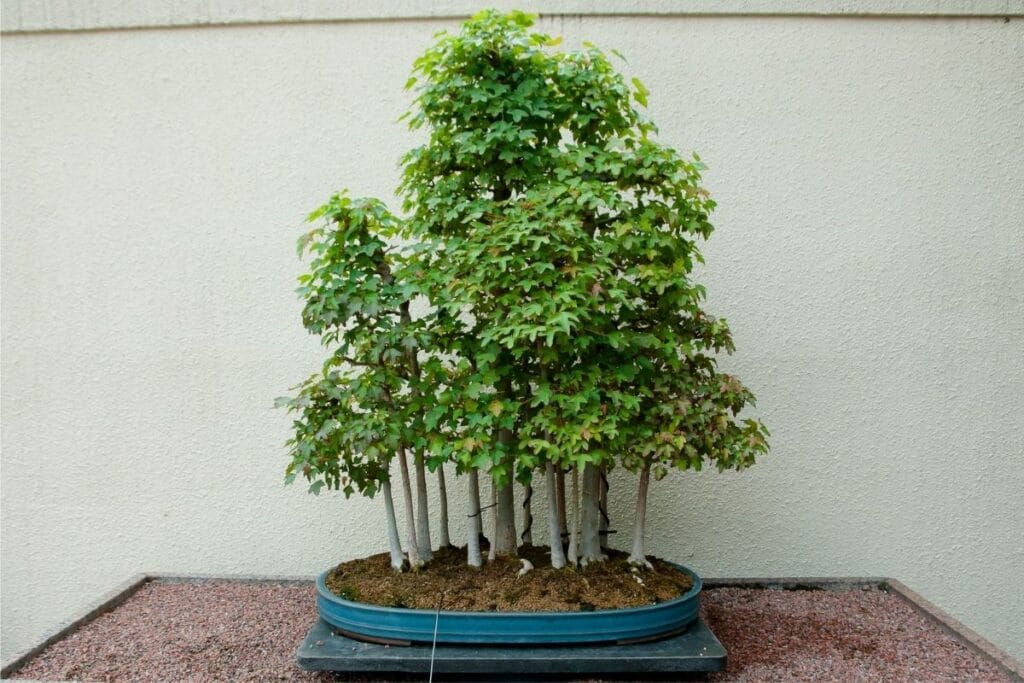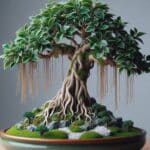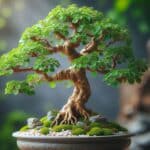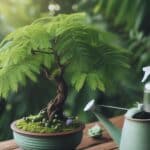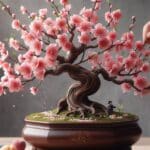Also known scientifically as Acer buergerianum, the trident maple is a deciduous tree that easily towers to heights of 45 feet or more in its native habitat.
However, its reputation for being a gargantuan tree in the wild shouldn’t deter you from growing it as a miniature masterpiece in the art of bonsai indoors. Popular as a patio or street tree, this plant is also a perfect bonsai specimen. It’s easy to care for and grows quickly.
Trident maple bonsai trees are highly sought after by bonsai enthusiasts because they produce thick, gnarled roots that are ideal for the root-over-rock aesthetic that many growers strive for. With attractive three-lobed leaves that turn from green into red, yellow, or orange along with bright yellow flowers, these trees are perfect for a bonsai experiment.
Getting the hang of growing trident maple bonsai is easy. Here’s what you need to know.
Interesting Facts about Trident Maple Tree
| Height | 8-10 inches |
| Width | 2-3 inches |
| Sunlight | Full sunlight |
| Flowering Time Length | 1-2 months |
| Lifespan | 80 years |
| Scientific Name | Acer buergerianum |
Growing Trident Maple Bonsai from Seed or by Propagation
Propagation trident maples is the easiest way to grow this plant. You can use cuttings adhered to in the early spring, as these will root relatively easily.
It can also be grown from seed, although it will take much longer. To do this, sow seeds in the fall about half an inch deep. The seeds should sprout in the spring and can be transplanted then, if you desire.
As you might infer, sowing from seed is only recommended in areas that do not receive a harsh winter freeze, as this can prevent them from germinating.
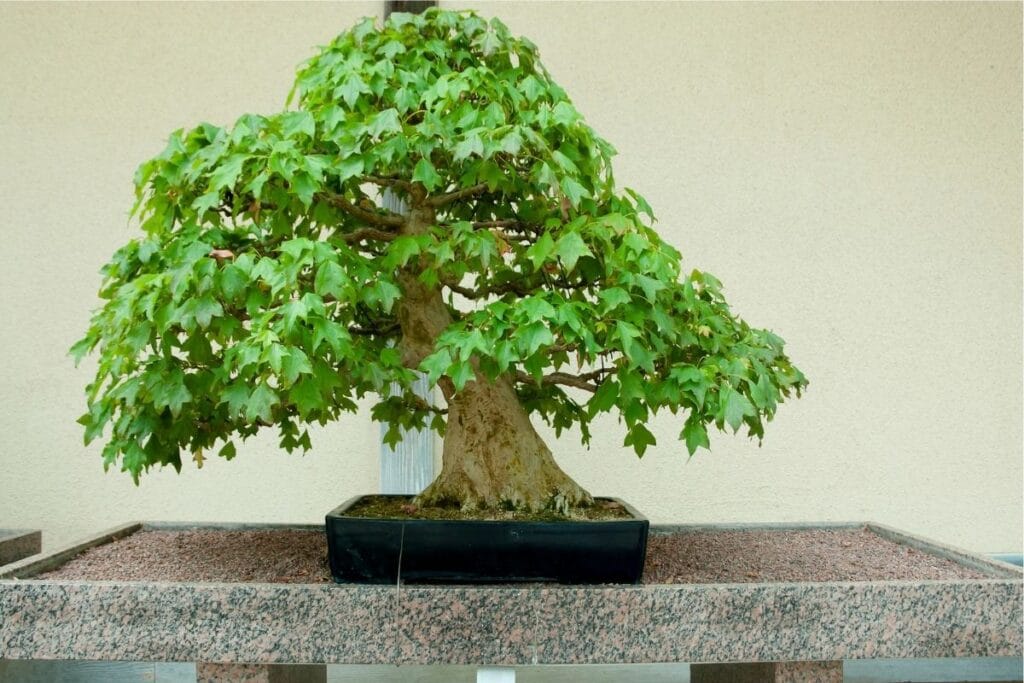
How to Care for Trident Maple Bonsai
Sunlight
Trident maple bonsai trees should always be grown in full sun. Although they can tolerate the occasional bit of shade, they prefer six or more hours of light each day. Provide this with natural lighting or full spectrum grow lights.
It’s also important to note that these deciduous need to be kept relatively warm. Their roots have a higher than average moisture content, meaning they are more vulnerable to frost damage. Because of this, this outdoor bonsai tree is best grown in warmer climates or completely indoors.
If you live in a cooler environment, you can always grow this bonsai specimen outdoors in the summer months only. Just make sure you bring it inside or put it in a warm garage or cold frame once temperatures drop to frost-prone ranges.
Watering
As mentioned earlier, the roots of trident maple bonsai are known to hold a fair amount of water. As a result, this bonsai tree tends to be more drought tolerant than other maple species. However, as a bonsai, it does still require regular watering
In the hottest moments of the summer, you may find that you need to water every day. In the winter, less watering is required (and less watering is actually recommended, as overwatering can cause damage to the roots in cold temperatures).
Either way, make sure your bonsai is planted in well draining soil and that the roots do not ever sit in water. This can lead to root rot.
Fertilizing
Although regular fertilizing is not necessary for older trident maple bonsai trees, it’s a must for young plants. Use a fertilizer that’s high in nitrogen but switch to one with less nitrogen as the tree ages. This will help produce a more controlled growth with smaller leaves, something that is highly sought after in the bonsai practice.
You should fertilize about once a week for the first month of new growth in the spring and then you can drop down to twice a month.
Potting and Repotting
The ideal time to repot or transplant your bonsai tree species is in the early spring, right before it starts to bud. You shouldn’t need to repot your tree until it has been growing for at least a year or two. After that, plan on repotting about once every three years. After repotting, keep it in a cool, shady environment for two weeks to prevent shock.
Consider using bonsai pots for your tree, as they provide the perfect size and drainage for maintaining healthy roots.
Pruning Trident Maple Bonsai
The best time to prune a trident maple bonsai is in the spring, right before it buds. You can cut more than half of the roots to fit the tree into its new container but it’s better to cut larger ones rather than tiny feeder roots.
You may also wire this tree at any time. However, be careful doing so, as the branches tend to be brittle.
If you prune back any leaves, avoid removing more than a third of the largest leaves. This can prevent the tree from storing energy for its dormant season.
Pests and Diseases
The acer buergerianum plant is not prone to very many pests and diseases. Occasionally, caterpillars might be a problem. To get rid of them, simply pluck them off by hand. No other pesticides or methods of control are necessary.
Diseases aren’t usually an issue, either, with the sole exception being fungal problems caused by overwatering. Make sure your tree’s roots aren’t allowed to stay wet in order to prevent this problem.
Where to Buy Trident Maple Bonsai
You can purchase trident maple bonsai seeds or plants from most bonsai specialty stores or nurseries, either online or in your local area. In many cases, it makes the most sense to purchase a starter plant from a specialty nursery to make sure you receive a high-quality plant from reliable stock.
FAQs
Can you keep a trident maple bonsai indoors?
While trident maple bonsai can tolerate brief periods indoors, they generally thrive outdoors due to their need for sunlight and proper air circulation.
How often should I water trident maple?
Water trident maple bonsai thoroughly when the top layer of bonsai soil feels dry, typically every 2-3 days during the growing season. Adjust frequency based on environmental factors like temperature and humidity.
What is the best soil for a trident maple bonsai tree?
Trident maple bonsai prefer well-draining soil mixes that retain moisture while allowing excess water to drain freely. A mix of akadama, pumice, and lava rock is commonly used.
Do trident maples grow fast?
Trident maples have a moderate growth rate, especially when young and well-cared for. With proper pruning and maintenance, they can develop into well-formed bonsai trees relatively quickly.
Why are the tips of my Trident Maple leaves turning brown?
Brown leaf tips on a trident maple bonsai can be due to underwatering, overfertilization, low humidity, or exposure to dry air. Ensure proper watering and humidity levels and avoid overfertilizing.
Up next: How to care for Japanese red maple bonsai tree
*photo by [email protected]/depositphotos
References
Reference List:
1. NC State Extension (n.d.) Acer Buergerianum. Available at: https://plants.ces.ncsu.edu/plants/acer-buergerianum/
2. California Polytechnic Institute Urban Forest Ecosystems Institute (n.d.) Trident Maple. Available at:
https://selectree.calpoly.edu/tree-detail/acer-buergerianum
Close

